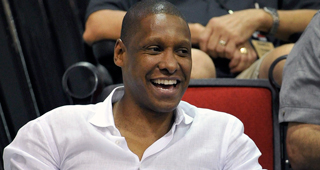The Toronto Raptors are coming off what was easily the most successful season in franchise history. They won seven more games than their previous high, topping 50 wins for the first time, and pushed the Cavaliers to six games in the Eastern Conference Finals. As the Raptors' veteran roster has come together and gelled, the question is: can they take the next step and reach the NBA Finals, or have they already peaked?
Helping Toronto reach their heights were Kyle Lowry and DeMar DeRozan playing as one of the best backcourts in the league. Lowry is the unquestioned leader of the team and made his second straight All-Star appearance. He averaged over 21 PPG on the best shooting of his career and played better defense than he has more recently. More importantly, he is the player the Raptors look to for leadership and to make a big play when they need it most.
DeRozan, despite having an old school game that doesn’t always translate well in the new NBA, had another All-Star season. DeRozan’s game involves a lot of mid-range looks, as he led the league in 2 Point attempts last season. He also got to the FT line at a career high rate and shot the best percentage of his career. Heading into his age 27 season, he hasn’t shown any slippage in his athleticism. But if that starts to slide he could see his offense suffer due to his inability to shoot from deep. These is a factor Toronto has to consider when trying to weigh giving DeRozan a big contract. He makes a great pairing with Lowry and both players love playing together, making chemistry a big factor as well.
Joining them in the backcourt is Cory Joseph, who enjoyed a career best season in his first year with Toronto. After a couple of years of steady play in the Spurs' system backing up Tony Parker, the Raptors were able to sign Joseph to a reasonable four-year contract paying him and an annual average of approximately $7.5 million. This was great work by Toronto to sign Joseph on a value deal before the cap spike. Joseph can play with Lowry and DeRozan in small lineups, allowing both of them to work off the ball. With a lot of teams looking for PG depth, the Raptors are in good hands, with Delon Wright also providing a young prospect at the position as well.
The Raptors have more concerns in the frontcourt. The Raptors signed Jonas Valanciunas to a four-year extension last summer that kicks in this year at an average of $16 million per year. Some considered this a questionable investment, but Toronto wanted to sign their young center before letting him the market. Valanciunas proved them right by having the best season of his career despite some injury troubles. He continued his extremely efficient offensive play in the post (including approximately a million pump fakes!) and improved defensively. He reduced his foul rate by playing more vertical and stopped reaching. He’s still somewhat of a liability in pick and roll coverages, but he’s improved enough that he’s no longer attacked repeatedly on that end of the floor.
His partner manning the pivot was breakout player Bismack Biyombo. After Charlotte declined to issue Biyombo a Qualifying Offer for fear he would sign it, the Raptors signed him for the Room Exception. Biyombo far exceeded both the QO and the Room Exception, especially in the playoffs when he filled in for Valanciunas. The challenge for Toronto is that he opted out of the second year of his deal and is now an unrestricted free agent. Compounding the issue is that the Raptors don’t have even Early Bird Rights for him either. With a tight cap situation, retaining Biyombo may prove impossible for the Raptors.
At the small forward position, Toronto thought they filled a hole with DeMarre Carroll after he broke out with Atlanta. Unfortunately for the Raptors, Carroll missed the majority of the year with injuries and didn’t play nearly as well as he had with the Hawks. Toronto has to hope he bounces back because they have a significant investment in him salary-wise and they need his production as both a SF and occasional small ball PF.
Behind Carroll, Terrence Ross continued his career norm of maddeningly inconsistent play. The overall numbers always look good for Ross, but his game log is filled with big performances followed by games where he is nearly invisible. Toronto signed him to a $10 million plus annual extension hoping that would reverse course, but it hasn’t yet.
Joining Ross as a backup wing was Norman Powell. Not regarded as much more than a developmental prospect, Powell ended up starting 24 games and showed promise for the future. He’s signed on a very friendly team deal at the minimum, so he’s likely to be a roster mainstay for at least the next couple of seasons.
That leaves us with the quagmire that was the Raptors' power forward position. The starter for most of the year was 35-year-old Luis Scola, who provided basically net neutral play. He was nothing special on either end, and often struggled defensively. At this point in his career, Scola needs to be playing 15-20 MPG as a backup PF/C. Relying on him to start is not a place a good team can afford to be.
The Raptors' backup PF was once again Patrick Patterson. He provided his typical stretch 4 game, with solid three-point shooting and good rebounding for a reserve. His defense leaves a lot to be desired, so this is likely Patterson’s role for the rest of his career. That isn’t a criticism though, as he seems to have embraced it and he fills it well.
Heading into the offseason, the Raptors have three main priorities. First, is to re-sign DeRozan. He’s the longest tenured franchise player and the Raptors need the continuity in their backcourt. After DeRozan, Toronto would love to find a way to bring Biyombo back. As covered above, this may prove extremely difficult. With so many teams having cap space this summer and rim protection en vogue around the league, Biyombo should have his pick of offers that the Raptors don’t have the ability to match. Finally, they have to upgrade the power forward rotation to continue their ascent as a real contender.
In the draft, Toronto has two picks at 9 and 27. The earlier pick is courtesy of the Knicks' gamble on Andrea Bargnani, which has turned into one of the more lopsided picks of recent memory. They need to fill their PF hole with a long-term answer that fits next to Valanciunas and can grow as the rest of the roster ages. They seem to have missed on their gamble from a couple of years ago, Bruno Caboclo, as he hasn’t shown the development the team wanted to see, playing in only 14 NBA games in two years. He is still very young however, turning 21 just before the season starts, so the Raptors still have hope he may develop into something.
Given the fact that Toronto signed both Valanciunas and Ross last summer, and their clear desire to bring back DeRozan, this may be a relatively quiet for Masai Ujiri. Adding a quality piece in the draft and finding some veterans to fill out the roster in addition to a re-signed DeRozan would be a successful offseason. That should be enough to leave the Raptors as contenders in the Eastern Conference, with hopes that unexpected development could push them past Cleveland and into the Finals.
Offseason Details
Guaranteed Contracts (10): Bruno Caboclo, DeMarre Carroll, Cory Joseph, Kyle Lowry, Lucas Nogueira, Patrick Patterson, Norman Powell, Terrance Ross, Jonas Valanciunas, Delon Wright
Partial/Non-Guaranteed Contracts (0): None
Potential Free Agents (5): Bismack Biyombo (UFA), DeMar DeRozan (UFA), James Johnson (UFA), Luis Scola (UFA), Jason Thompson (UFA)
“Dead” Money on Cap (0): None
First Round Draft Picks: #9, #27
Maximum Cap Space: $21,003,159
Projected Cap Space: None. $9,224,030 over



